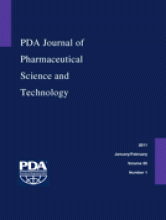Abstract
The microbial growth potential of a pharmaceutical drug product refers to the ability of microorganisms to survive and proliferate in the product. Each drug formulation possesses a different potential for supporting or inhibiting microbial growth. Understanding this microbial growth potential can have a significant effect on the development and design of the drug manufacturing process. This article describes how this attribute can exert this effect on manufacturing process development and design through real examples and case studies obtained from the regulatory review of new drug and biologics license applications. In addition, this article describes how understanding the microbial growth potential of a pharmaceutical drug product is an element of the Quality by Design paradigm and how this understanding can simplify the drug development process and lead to better process design.
LAY ABSTRACT: The microbial growth potential of a pharmaceutical drug product refers to the ability of microorganisms to survive and proliferate in the product formulation. Each drug product formulation possesses a different potential for supporting or inhibiting microbial growth depending on its components. Understanding this microbial growth potential can have a significant effect on the development and design of the drug manufacturing process. This article describes how this attribute can affect manufacturing process development and design through real examples and case studies obtained from the regulatory review of new drug and biologics license applications. In addition, this article describes how understanding the microbial growth potential of a pharmaceutical drug product is an element of the Quality by Design paradigm and how this understanding can simplify the drug development process and lead to better process design.
- Quality by Design
- QbD
- Microbial growth
- Pharmaceuticals
- Water activity
- New drug application
- Biologics license application
- ©PDA, Inc. 2011
PDA members receive access to all articles published in the current year and previous volume year. Institutional subscribers received access to all content. Log in below to receive access to this article if you are either of these.
If you are neither or you are a PDA member trying to access an article outside of your membership license, then you must purchase access to this article (below). If you do not have a username or password for JPST, you will be required to create an account prior to purchasing.
Full issue PDFs are for PDA members only.
Note to pda.org users
The PDA and PDA bookstore websites (www.pda.org and www.pda.org/bookstore) are separate websites from the PDA JPST website. When you first join PDA, your initial UserID and Password are sent to HighWirePress to create your PDA JPST account. Subsequent UserrID and Password changes required at the PDA websites will not pass on to PDA JPST and vice versa. If you forget your PDA JPST UserID and/or Password, you can request help to retrieve UserID and reset Password below.






